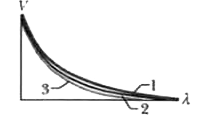Light is incident on the cathode of a photocell and the stopping voltages are measured from light of two difference wavelengths. From the data given below, determine the work function of the metal of the cathode in eV and the value of the universal constant hc/e.
Wavelength (Å) Stopping voltage (volt)
4000 1.3
4500 0.9
Let the work function of the surface be ϕ. If v be the frequency of the light falling on the surface, then according the Einstein's photoelectric equation, the maximum kinetic energy KEmax of emitted electron is given by
KEmax=hv−ϕ=hcλ−ϕ
We know that, KEmax=eV0
Where V0= cut-off potential
or eV0=hcλ−ϕ or V0=hceλ−ϕe
Now, ΔV0=V02−V01
=(hceλ2−ϕe)−(hceλ1−ϕe)
=hce(1λ2−1λ1)=hce(λ1−λ2λ1λ2) ......(1)
(b) From equation (1), we have
hce=ΔV0(λ1λ2)λ1−λ2
=(1.3−0.9)[(4000×10−10)×(4500×10−10)]500×10−10
=1.44×10−6V/m
Now, V0=hceλ−ϕe
or
ϕe=hceλ−V0=1.44×10−64000×10−10−1.3=2.3V
or ϕ=2.3eV
Topper's Solved these Questions
- BOOK - MOTIONCHAPTER - MODERN PHYSICS -1EXERCISE - EXERCISE-150videos
MODERN PHYSICS -1
- BOOK - MOTIONCHAPTER - MODERN PHYSICS -1EXERCISE - EXERCISE-2(LEVEL-I)34videos
MODERN PHYSICS -1
- BOOK - MOTIONCHAPTER - MODERN PHYSICS - 2EXERCISE - EXERCISE - 4 (Level -II) PREVIOUS YEAR - JEE ADVANCED28videos
MODERN PHYSICS - 2
- BOOK - MOTIONCHAPTER - NEWTON'S LAWS OF MOTION & FRICTION EXERCISE - Exercise - 3 Section-B12videos
NEWTON'S LAWS OF MOTION & FRICTION
Similar Questions
(a) If the wavelength of the light incident on a photoelectric cell be reduced from λ1 to λ2Å, then what will be the change in the cut-off potential?
(b) Light is incident on the cathode of a photocell and the stopping voltages are measured for light of two different wavelengths. From the data given below, determine the work function of the metal of the cathode in eV and the value of the universal constant hc/e.
WavelengthÅStopping voltage (volt)40001.345000.9View SolutionElectrons are emitted from the cathode of a photocell of negligible work function, when photons of wavelength λ are incident on it. Derive the expression for the de Broglie wavelength of the electrons emitted in terms of the wavelength of the incident light
View Solution
Knowledge Check
- Question 1 - Select One
If stopping potentials corresponding to wavelengths 4000A and 4500A are 1.3 V and 0.9 V, respectively, then the work function of the metal is
A0.3 eVB1.3 eVC2.3 eVD5 eV - Question 2 - Select One
A metal is irradiated with light of wavelength 660 nm. Given that the work function of the metal is 1.0eV, the de Broglie wavelength of the ejected electron is close to-
A6.6×10−7mB8.9×10−11mC1.3×10−9mD6.6×10−13m - Question 3 - Select One
Light from a hydrogen tube is incident on the cathode of a photoelectric cell the work function of the cathode surface is 4.2eV. In order to reduce the photo - current to zero the voltage of the anode relative to the cathode must be made
A−4.2VB−9.4VC−17.8VD+9.4V
Metal surface emits photoelectrons when light of wavelength 400 nm is incident on it. Calculate the work function of the metal if stopping potential is 0.5 V.
View SolutionThe cathode of a photocell is irradiated with light of wavelength 3000Å. The current through the cell is found to stop when the potential of the plate is 2.1 V just below the cathode. Calculate the work function of the cathode.
View SolutionIn the following figure gives the stopping voltage V versus the wavelength λ of light for three different materials. Rank the materials according to their work function, greatest first.
 View Solution
View SolutionThe radiation of wavelength 332 nm is incident on a metal of work function 1.70 eV. The value of the stopping potential will be
View SolutionLight from a hydrogen tube is incident on the cathode of a photoelectric cell the work function of the cathode surface is 4.2eV. In order to reduce the photo - current to zero the voltage of the anode relative to the cathode must be made
View Solution
